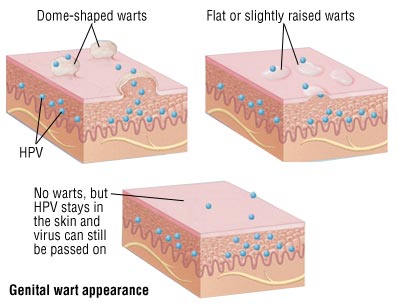Genital Warts

Having genital warts isn’t the end of the world. If it were, the world would have ended a very long time ago. Not only are genital warts one of the most common sexually transmitted infections (STIs) known to mankind, they’re also one of the oldest. If you have genital warts, you’re not alone, and the infection can be treated. It’s estimated that one in every three people either has active genital warts or is a carrier of the virus that can cause them.
Some experts argue that the figure is actually closer to about 50 percent of all sexually active people. In any case, the odds are good that you’ll become infected at some point in your life. In fact, if you’ve had any sexual contact, you’ve more than likely been exposed to the virus already. Genital warts should always be evaluated with a thorough consultation and physical examination for an accurate diagnosis and treatment plan in order to exclude any underlying serious condition.
The Virus Behind the Warts
Genital warts are caused by HPV (human papillomavirus). There are over 100 known strains of HPV, 40 of which are sexually transmitted. Most are benign; others are more troublesome. HPV can cause warts on your genitals, in your rectum, or even in your throat. While most types of this virus cause warts, others can cause cancer — such as cervical cancer, anal cancer, penile cancer, oral cancer, throat cancer, and cancer of the vulva. HPV related cancers have increased in recent decades.
There are vaccines designed to protect you against the most common strains of sexually transmitted HPV. Check with your dermatologist in New York City for treatment options.
Who’s at Risk
Anybody who is sexually active in any way is at risk. However, the longer you’ve been sexually active — and the larger number of sexual partners you’ve had — greatly contribute to your chances of contracting the virus and developing genital warts. But understand that having sex one time, with a single person, is enough to become infected. Some other factors that raise your odds for infection include:
- Having unprotected sex
- Beginning to have sexual contact at a young age.
- Being a woman — the simple issue of gender increases your chances of contracting genital warts, as nearly 80 percent of women will be infected at least once by the time they reach age 50
- Where you live — in larger, more densely populated places like New York City, infection rates are especially high simply because of the sheer number of sexually active people living so closely together.
The Signs of Genital Warts
Genital warts usually look like small, flesh-colored bumps that appear in or around your genitals. They can appear individually or in clusters that resemble tiny clusters of cauliflower. Sometimes, genital warts aren’t even big enough to be seen by the naked eye, which is why you should get regular check-ups with your NYC dermatologist. Common Locations for genital warts include:
- Women: vulva, vaginal walls, cervix, or the skin between their vagina and anus
- Men: scrotum, the head of the penis or the shaft of the penis
- Both men and women can contact them in the anus, mouth, or throat
It‘s possible that you experience some itching or discomfort from genital warts, but they are mostly asymptomatic. Warts may bleed during sex if they’re located in a place that’s going to be rubbed or irritated frequently. Unlike herpes, syphilis, or other viral sexually transmitted diseases (STDs), there are no additional symptoms, like a fever or achy body, to alert you that you aren’t well.
Possible Complications of Untreated Warts
It’s possible that warts can become enlarged and block the urethra or rectum, making it difficult for you to relieve yourself. HPV can also cause complications during pregnancy. Warts left on your vaginal walls could affect the ability of your vaginal tissue to stretch while giving birth. This could cause vaginal rips or tears from the pressure and stress of the birth. Vaginal warts can stretch and bleed, making the birth more painful than it needs to be. In extremely rare cases, babies born to mothers with genital warts can develop warts in their throats.
When to Seek Medical Attention
If you notice any suspicious bumps or warts on you or your partner’s genital area, it’s time to seek medical attention. It’s common for women to be unaware of warts inside the vaginal canal. This is one reason why it is important for you to stay current with your Pap smears and gynecological exams.
Many men never realize they have the virus because they never experience any symptoms. Even in these cases, the virus can still be transmitted from men to their partners. Men and women without symptoms are called carriers. Their lack of symptoms is one of the reasons that HPV has become so common.
What You Can Do About Warts
Always leave the treatment of genital warts to highly trained professionals like your dermatologist in Manhattan. You may have to be treated more than once, though, because genital warts can come back over time. But there are a variety of treatment options available. The solutions your dermatologist provides may provide you with the best options. As a doctor specializing specifically in treating skin conditions, your dermatologist has a unique understanding of the problem and the most options for treating your genital warts.
Important Reminder: This information is only intended to provide guidance, not definitive medical advice. Please consult dermatologist NYC about your specific condition. Only a trained, experienced board certified dermatology doctor or pediatric dermatologist could determine an accurate diagnosis and proper treatment.
Locations: Manhattan Dermatology (Upper East Side) 983 Park Ave, Ste 1D1, NY 10028(212) 427-8750 Manhattan Dermatology (Midtown) 56 W 45th St, Ste 819, NY 10036
(212) 889-2402 Manhattan Dermatology (Union Square) 55 W 17th St, Ste 103, NY 10011
(212) 378-9984

